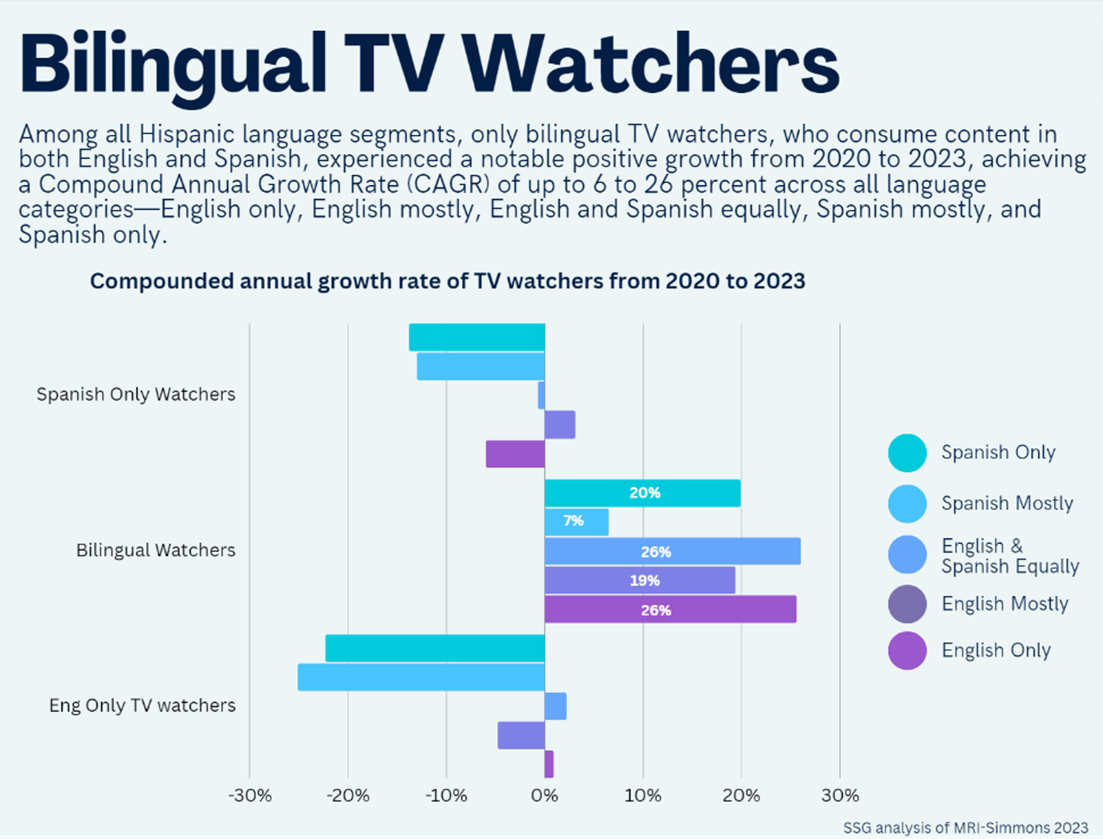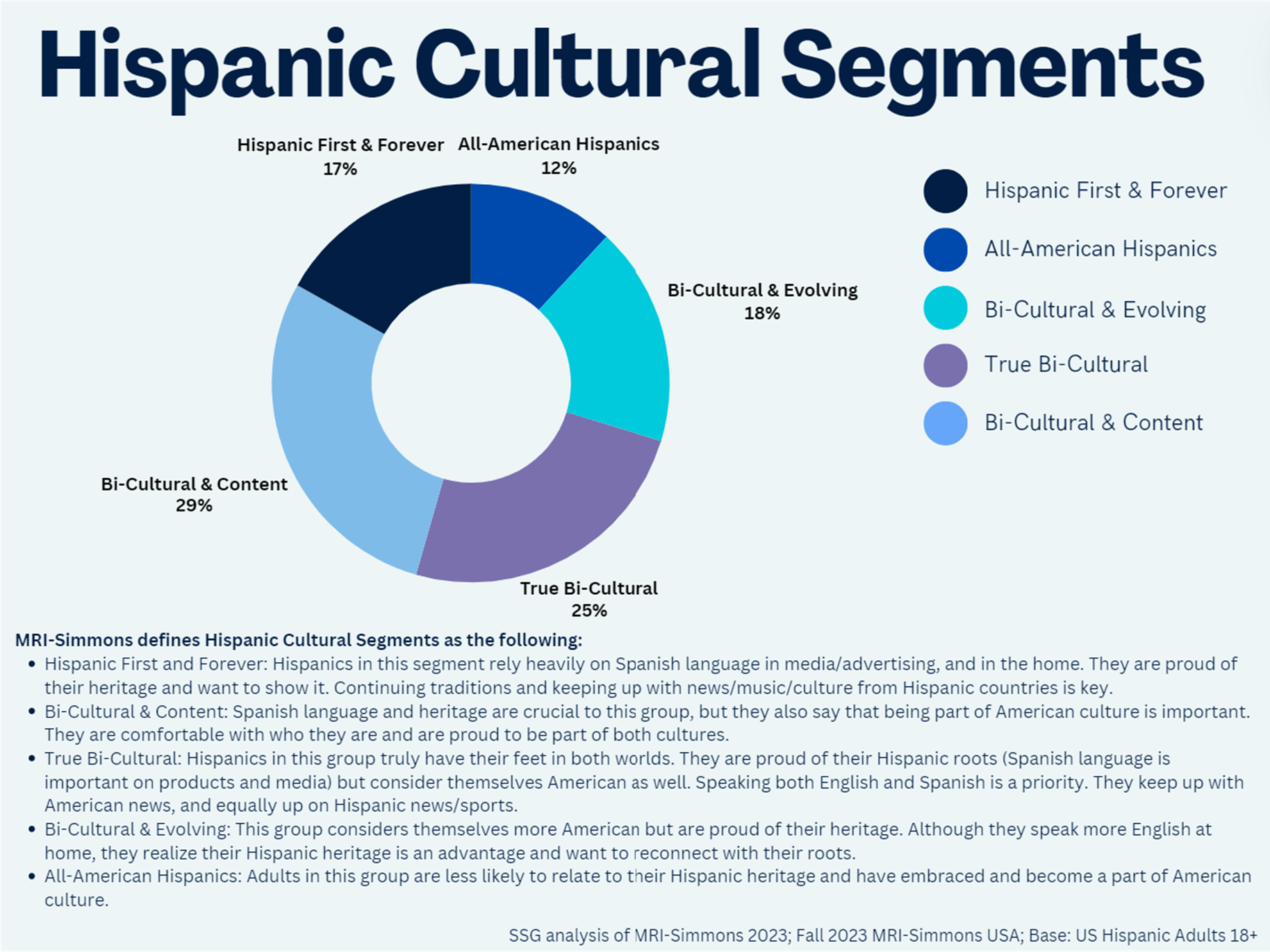For many Hispanics, Spanish language is regarded as a cultural symbol and expression of their Latinidad. Throughout the last few decades, Hispanic immigration into the US has steadily increased to a present-day population of 62 million US Hispanics. This steady influx of Hispanic immigration has contributed to a growing media, advertising, and communications landscape that caters to English-dominant, Spanish-dominant, and bilingual Hispanics.
Growing Up Hispanic
Traditions, cultural foods, celebrations, and Spanish language are often passed down from parent to child in Hispanic households. Around 48% of Hispanics in the US recall learning Spanish as their first language, and around 3 in 4 (73%) say that they learned Spanish under 3 years old.[1] This shows that for many Hispanic parents, passing down culture through language is a priority and an expression of their culture. Additionally, passing down language is also seen as an important tool for connecting and engaging with the latest expressions of Hispanic pop culture and media.
In a world where multicultural consumers are demanding more authenticity and acknowledgment of their identities and culture from brands and the media, Spanish language has been an effective and helpful tool in Hispanic outreach and communications. As a recent Hispanic audience report by Nielsen notes, Hispanics are gravitating less towards cable television, and are opting more for streaming because it allows them to personalize their content according to their identities and experiences[2]. Streaming presents consumers with a wider variety of on-demand content options that connect with consumers’ culture, identity, experiences, sexuality, and language.
US Hispanic Population Growth Influences Bilingual Media Consumption
Hispanic identity is complex and multi-faceted and is expressed through various mediums such as food, celebrations, customs, art, music, relationships, etc. And for many Hispanics, consuming media in Spanish is a way to get closer to their culture and see themselves reflected on air. Over the last 3 years (2020-2023), bilingual Hispanics (Hispanics who speak English and Spanish equally), have seen a major 26% uptick among those who watch television in both English and Spanish. Moreover, according to MRI-Simmons, 54% of US adult Hispanics are bilingual, consisting of those who in their homes speak English Mostly, Spanish Mostly, and/or English and Spanish equally.[3]
Fluctuations in TV consumption concerning language among US Hispanics have been affected by dynamic, cultural, and linguistic trends. During this period, English Mostly Hispanics (Hispanics who mostly speak English at home) increased their television watching in both languages by 19%, while Spanish Mostly lagged, only increasing their television watching in both languages by 7% from 2020 to 2023. The growth lag in Spanish Mostly Hispanics’ television watching in both languages may not come as a surprise to some, Moreover, US Hispanic growth in the last decade is mostly attributed to new births (approximately 1 million US Hispanic babies born every year since 2010), rather than immigration, as immigration has slowed significantly since the ‘80s and ‘90s and no longer drives US Hispanic population growth.[4] These demographic fluctuations can offer some insights into the shifts observed in TV watching and media consumption trends among Hispanics, concerning Spanish and bilingual media consumption.

What this shift means for Hispanics in 2024 and beyond
Growth in bilingual TV watching (watching TV/video content in English and Spanish) could be attributed to the demographic US Hispanic population shifts mentioned previously. However, considering society’s push for furthering equality and cultural expression, US Hispanics and multicultural segments, in general, are less likely to feel pressure to assimilate into American culture as other previous Hispanic generations did. According to MRI-Simmons data from 2023, around three-quarters of Hispanics consider themselves to be bi-cultural.[5]

Many Hispanics have become more comfortable embracing their Hispanic identity and biculturalism, even if it means they are more proficient in English than Spanish. Today’s GenZ and Millennial Hispanics are redefining what it means to be Hispanic. As Jacqueline Delgadillo put it in the Refinery29 article titled, “We’re Redefining What It Means to be a ‘No Sabo’ Kid,” Delgadillo states, “Language doesn’t come naturally; we’re not born meant to speak a specific one. Language is taught, and not all of us have access to the same level of education or resources. Not speaking a language properly, or at all, doesn’t make someone less Latinx. We all have the right to celebrate and connect to our cultures however we choose.” Hispanics are becoming more comfortable with embracing their own cultural identities, despite their level of acculturation or language proficiency. The growth outlined previously for bilingual TV watching among all Hispanic language levels shows us that despite Spanish language proficiency, Hispanics are not shying away from embracing all shades of Hispanic culture and language. In addition, according to SSG’s analysis of MRI-Simmons in 2023, 55% of US Hispanic adults said that they try to stay up to date with the latest Latino music and cultural trends from Hispanic countries.[6] The increasing presence of Hispanics in mainstream pop culture, bolstered by renowned reggaeton performers like Bad Bunny and Karol G, facilitates connections among Hispanics and with individuals from diverse racial and ethnic backgrounds. SSG analysis of 2023 MRI-Simmons also uncovered that 69% of US Hispanic adults said they would like to feel more Hispanic and closer to their roots.[7] US Hispanic adults desire to be closer to their culture and are looking for more ways to express it. Their Hispanic identity gives them a strong sense of pride and is a point of connection with other Hispanics.
his presents marketers with a unique opportunity in which Hispanics and their multi-faceted culture, and identities can be portrayed in various ways. In addition, marketers can also utilize these demographic and cultural changes among Hispanics to create dynamic targeting and communications strategies that are more authentic and inclusive of the US Hispanic experience, intersectionality, and tapestry.
For reference:
[1] 54% of US Hispanics are Bilingual. Can Your Brand Speak to them?, Briana Mendez, Sirius XM Media 2023.
[2] Hispanic Audiences in Focus: Trust in media – the key factor driving shift to streaming, Nielsen, 2023
[3] SSG analysis of MRI-Simmons Double-Base, 2023
[4] Key facts about U.S. Latinos for National Hispanic Heritage Month, Jens Manuel Krogstad, Jeffrey S. Passel, Mohamad Moslimani and Luis Noe-Bustamante, Pew Research, 2023
[5] The State of the Hispanic American Consumer 2023, MRI-Simmons USA; Spring 2023; Base: All Hispanic Adults 18+
[6] MRI-Simmons USA; Fall 2023; Base: All Hispanic Adults 18+
[7] MRI-Simmons USA; Fall 2023; Base: All Hispanic Adults 18+
